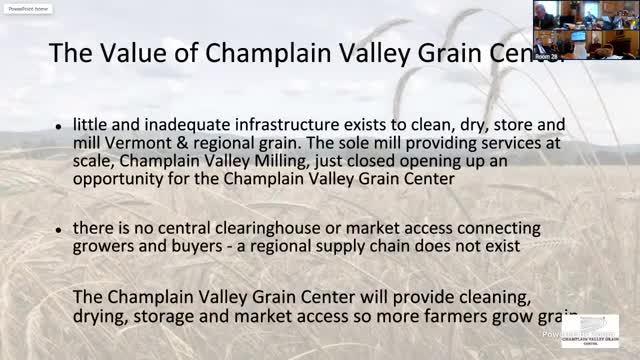
This article was created by AI using a video recording of the meeting. It summarizes the key points discussed, but for full details and context, please refer to the video of the full meeting. Link to Full Meeting
One speaker passionately articulated the health risks associated with chemically grown grains, linking them to rising cancer rates among farmers and increasing gluten intolerances among consumers. The call for organic farming practices resonated throughout the room, emphasizing the dual benefits of producing healthier food and nurturing the soil. “By growing grain in Vermont with less chemicals organically, we can provide something that's more nutritious for the consumer and for the farmer to grow,” they stated, underscoring the importance of local agriculture for both health and environmental sustainability.
The conversation also touched on the unique appeal of Vermont-grown products. Participants reminisced about the pride associated with local branding, noting that products labeled as “grown and produced in Vermont” carry a special significance. This branding not only supports local farmers but also enhances the state’s tourism appeal, as visitors are drawn to the picturesque landscapes shaped by agricultural practices.
As the meeting progressed, the focus shifted to the future of Vermont agriculture. The speakers expressed a strong belief that the state is not in decline but rather on the cusp of growth. They emphasized the importance of attracting young farmers who are eager to innovate and expand market share while being mindful of financial sustainability. “We need to keep on expanding those markets,” one participant urged, highlighting the need for investment in infrastructure to support this growth.
The discussion concluded with a call to action for the state’s agricultural committee to identify key areas for investment. Infrastructure improvements were deemed crucial, with specific mention of leveraging funds to enhance local production capabilities. The meeting ended on a hopeful note, with participants committed to telling the story of Vermont agriculture and its potential to thrive once again as a breadbasket of the nation.
Converted from Senate Agriculture - 2025-02-26 - 9:00 AM meeting on February 26, 2025
Link to Full Meeting
Comments
View full meeting
This article is based on a recent meeting—watch the full video and explore the complete transcript for deeper insights into the discussion.
View full meeting